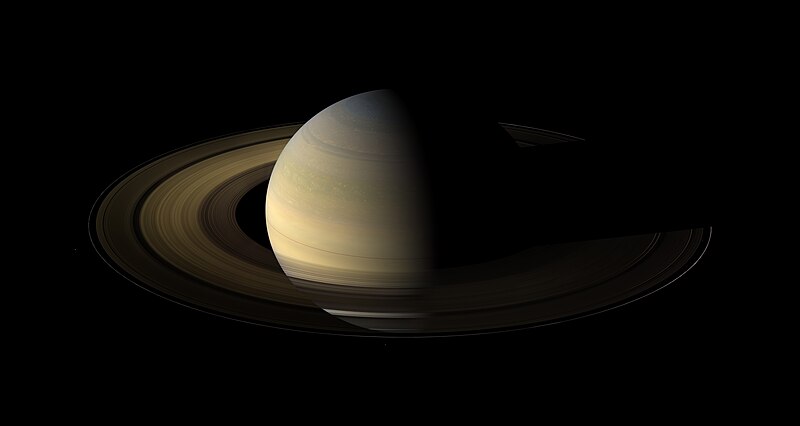Archivo:Saturn, its rings, and a few of its moons.jpg

Tamaño de esta previsualización: 800 × 426 píxeles. Otras resoluciones: 320 × 170 píxeles · 640 × 341 píxeles · 1024 × 545 píxeles · 1280 × 681 píxeles · 2560 × 1363 píxeles · 7227 × 3847 píxeles.
Ver la imagen en su resolución original (7227 × 3847 píxeles; tamaño de archivo: 3,58 MB; tipo MIME: image/jpeg)
Historial del archivo
Haz clic sobre una fecha y hora para ver el archivo tal como apareció en ese momento.
| Fecha y hora | Miniatura | Dimensiones | Usuario | Comentario | |
|---|---|---|---|---|---|
| actual | 16:08 7 jun 2014 |  | 7227 × 3847 (3,58 MB) | NH2501 | Lower compression, taken from http://www.dlr.de/media/en/desktopdefault.aspx/tabid-4986/8423_read-12880/8423_page-2 |
| 18:24 21 sep 2009 |  | 7227 × 3847 (1018 kB) | Originalwana | {{Information |Description={{en|1=Seen from our planet, the view of Saturn's rings during equinox is extremely foreshortened and limited. But in orbit around Saturn, Cassini had no such problems. From |
Usos del archivo
La siguiente página usa este archivo:
Uso global del archivo
Las wikis siguientes utilizan este archivo:
- Uso en ar.wikipedia.org
- تيتان (قمر)
- زحل
- هايبريون
- عملاق غازي
- إنسيلادوس
- برنامج فوياجر
- بيونير 11
- كاسيني-هويجنز
- أطلس (قمر)
- أقمار زحل
- برومثيوس (قمر)
- باندورا (قمر)
- بان (قمر)
- ميماس
- S/2009 S 1
- جانوس (قمر)
- S/2007 S 2
- دافنيس (قمر)
- هاتي (قمر)
- بيستلا (قمر)
- S/2007 S 3
- S/2006 S 3
- S/2004 S 7
- فارباوتي (قمر)
- طرقيق
- ديون (قمر)
- سكول (قمر)
- جريب (قمر)
- نارفي (قمر)
- فورنجوت (قمر)
- هيروكين (قمر)
- آيجير
- سكاثي (قمر)
- بيرجلمير (قمر)
- تريمر
- جارنساكسا (قمر)
- كاري (قمر)
- مونديلفاري (قمر)
- سورتور (قمر)
- بيبهيون (قمر)
- لوج (قمر)
- فينرير (قمر)
- إريابوس
- يمير (قمر)
- سوتونجر (قمر)
- كيفيويك (قمر)
- بالياق
- S/2004 S 4
- S/2006 S 1
- S/2004 S 13
Ver más uso global de este archivo.


